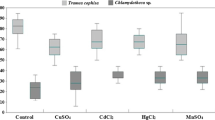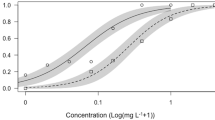Abstract
The ecological risk assessment of pesticides is generally based on toxicity data obtained from single-species laboratory experiments and does not take into account ecological interactions such as competition or predation. Intraspecific and interspecific competition are expected to result in additional stress and might increase the sensitivity of aquatic populations to pesticide contamination. To test this hypothesis, the effects of the fungicide carbendazim were assessed on the population dynamics of the micro-crustacean Daphnia magna under different levels of intraspecific and interspecific competition for an algal food resource, using the rotifer Brachionus calyciflorus as competing species. The experiments were performed in glass jars with three different carbendazim concentrations (i.e., 50, 100 and 150 µg/L), and had a duration of 25 days, with a 4-day pre-treatment period in which competition was allowed to take place and a 21-day exposure period. The endpoints evaluated were D. magna total population abundance and population structure. Results of these experiments show that competition stress on its own had a significant influence on shaping D. magna population’s structure, however, a different response was observed in the intraspecific and interspecific competition experiments. The use of a 4-day pre-treatment period in the intraspecific experiment already led to an absence of interactive effects due to the quick abundance confluence between the different intraspecific treatments, thus not allowing the observation of interactive effects between competition and carbendazim stress. Results of the interspecific competition experiment showed that rotifers were quickly outcompeted by D. magna and that D. magna even profited from the rotifer presence through exploitative competition, which alleviated the original stress caused by the algal resource limitation. These experiments suggest that competition interactions play an important role in defining population-level effects of pesticides in a more complex way than was hypothesized (“increasing competition leading to a sensitivity increase”), as the interspecific experiment showed. Therefore, these should be taken into account in the extrapolation of single-species toxicity data to protect higher levels of biological organization.



Similar content being viewed by others
References
Antunes SC, Castro BB, Gonçalves F (2004) Effect of food level on the acute and chronic response of daphnids to lindane. Environ Pollut 127:367–375
Barata C, Baird DJ, Soares AMVM (2002) Demographic responses of a tropical cladoceran to cadmium: effects of food supply and density. Ecol Appl 12:552–564
Boone MD, Semlitsch RD (2002) Interactions of an insecticide with competition and pond drying in amphibian communities. Ecol Appl 12:307–316
Brooks AC, Gaskell PN, Maltby LL (2009) Importance of prey and predator feeding behaviours for trophic transfer and secondary poisoning. Environ Sci Technol 43:7916–7923
Buser CC, Spaak P, Wolinska J (2012) Disease and pollution alter Daphnia taxonomic and clonal structure in experimental assemblages. Freshw Biol 57:1865–1874
Chandini T (1988) Effects of different food (Chlorella) concentrations on the chronic toxicity of cadmium to survivorship, growth and reproduction of Echinisca triserialis (Crustacea: Cladocera). Environ Pollut 54:139–154
Coors A, De Meester L (2008) Synergistic, antagonistic and additive effects of multiple stressors: predation threat, parasitism and pesticide exposure in Daphnia magna. J Appl Ecol 45:1820–1828
Cuppen JGM, Van den Brink PJ, Uil KF, Camps E, Brock TCM (2000) Impact of the fungicide carbendazim in freshwater microcosms. I Water quality, breakdown of particulate organic matter and responses of macro-invertebrates. Aquat Toxicol 48:233–250
Daam MA, Satapornvanit K, Van den Brink PJ, Nogueira AJA (2010) Direct and indirect effects of the fungicide carbendazim in tropical freshwater microcosms. Arch Environ Contam Toxicol 58:315–324
De Laender F, Janssen CR (2013) Brief communication: the ecosystem perspective in ecotoxicology as a way forward for the ecological risk assessment of chemicals. Integr Environ Assess Manag 9:34–38
Del Arco AI, Parra G, Rico A, Van den Brink PJ (2015) Effects of intra- and interspecific competition on the sensitivity of aquatic macro-invertebrates to carbendazim. Ecotoxicol Environ Saf 120:27–34
Driskell WB, Ruesin JL, Less DC, Houghton JP, Lindstrom SC (2001) Long-term signal of disturbance: Fucus gardneri after the Exxon Valdez oil spill. Ecol Appl 11:815–827
Ferrando MD, Janssen C, Andreu E, Persoone G (1993) Ecotoxicological studies with the freshwater rotifer Brachionus calyciflorus. Resource competition between rotifers and daphnids under toxic stress. Sci Total Environ 134:1059–1069
Fleeger JW, Carman KR, Nisbet RM (2003) Indirect effects of contaminants in aquatic ecosystems. Sci Total Environ 317:207–233
Foit K, Kaske O, Wahrendorf DS, Duquesne S, Liess M (2012) Automated nanocosms test systems to assess the effects of stressors on two interacting populations. Aquat Toxicol 109:243–249
Forbes VE, Sibly RM, Calow P (2001) Toxicant impacts on density-limited populations: a critical review of theory, practice, and results. Ecol Appl 11:1249–1257
Gergs A, Zenker A, Grimm V, Preuss TG (2013) Chemical and natural stressors combined: from cryptic effects to population extinction. Sci Rep 3:2036
Gilbert JJ (1985) Competition between rotifers and Daphnia. Ecology 66:1934–1950
Gui Y, Grant A (2008) Joint effects of density dependence and toxicant exposure on Drosophila melanogaster populations. Ecotoxicol Environ Saf 70:236–243
Ha JY, Hanazato T (2009) Role of interference from Daphnia and predation by cyclopoid copepods in zooplankton community structure: experimental analysis using mesocoms. Plankton Benthos Res 4:147–153
Knillmann S, Stamplfli NC, Beketov MA, Liess M (2012) Intraspecific competition increases toxicant effects in outdoor pond microcosms. Ecotoxicol 21:1857–1866
Liess M (2002) Population response to toxicants is altered by intraspecific interaction. Environ Toxicol Chem 21:138–142
Liess M, Foit K (2012) Intraspecific competition delays recovery of population structure. Aquat Toxicol 97:15–22
Linke-Gamenick I, Forbes VE, Sibly RM (1999) Density-dependent effects of a toxicant on life-history traits and population dynamics of a capitellid polychaete. Mar Ecol Prog Ser 184:139–148
Loureiro C, Pereira JL, Pedrosa MA, Conçalves F, Castro BB (2013) Competitive outcome of Daphnia-Simocephalus experimental microcosms: salinity versus priority effects. PLoS One 8(8):e70572. doi:10.1371/journal.pone.0070572
Maslankiewicz L, Linders J (1993) Milieufiche carbendazim. Bilthoven, RIVM, p 87p
OECD (2008) OECD guidelines for the testing of chemicals. No. 211, Daphnia magna Reproduction Test
Relyea R, Hoverman J (2006) Assessing the ecology in ecotoxicology: a review and synthesis in freshwater systems. Ecol Lett 9:1157–1171
Rubach MN, Crum SJH, Van den Brink PJ (2011) Variability in the dynamics of mortality and immobility responses of freshwater arthropods exposed to chlorpyrifos. Arch Environ Contam Toxicol 60:708–721
Scheffer M, Carpenter S, Foley JA, Folke C, Walker B (2001) Catastrophic shifts in ecosystems. Nature 413:591–596
Scherer C, Seeland A, Oehlmann J, Müller R (2013) Interactive effects of xenobiotic, abiotic and biotic stressors on Daphnia pulex: results from a multiple stressor experiment with a fractional multifactorial design. Aquat Toxicol 138–139:105–115
Slijkerman DME, Baird DJ, Conrad A, Jak RG, Van Straalen NM (2004) Assessing structural and functional plankton responses to carbendazim toxicity. Environ Toxicol Chem 23:455–462
Stampfli NC, Knillmann S, Liess M, Beketov MA (2011) Environmental context determines community sensitivity of freshwater zooplankton to a pesticide. Aquat Toxicol 104:116–125
Tollrian R (1993) Neck teeth formation in Daphnia pulex as an example of continuous phenotypic plasticity: morphological effects of Chaoborus kairomone concentration and their quantification. J Plankton Res 15:1309–1318
Van den Brink PJ (2008) Ecological risk assessment: from book-keeping to chemical stress ecology. Environ Sci Technol 42:8999–9004
Van den Brink PJ (2013) Assessing aquatic population and community-level risks of pesticides. Environ Toxicol Chem 32:972–973
Van den Brink PJ, Hattink J, Bransen F, Van Donk E, Brock TCM (2000) Impact of the fungicide carbendazim in freshwater microcosms. II. Zooplankton, primary producers and final conclusions. Aquat Toxicol 48:251–264
Van Wijngaarden RPA, Crum SJH, Decraene K, Hattink J, van Kammen A (1998) Toxicity of Derosal (active ingredient carbendazim) to aquatic invertebrates. Chemosphere 37:673–683
Viaene K, De Laender F, Rico A, Van den Brink PJ, Di Guardo A, Morselli M, Janssen CR (2015) Combined effects of intra- and interspecific interactions and pyrene on Daphnia magna populations. Environ Toxicol Chem. doi:10.1002/etc.2973
Wootton JT (2002) Indirect effects in complex ecosystems: recent progress and future challenges. J Sea Res 48:157–172
Acknowledgments
The authors thank John Beijer, Marie-Claire Boerwinkel and Ivo Roessink for providing useful advices, and Carry van Mameren and Steven Crum for performing the chemical analysis. The Chimera project is financed by the Long Range Initiative of CEFIC (www.cefic-lri.org; Project code: LRI-ECO19). The authors would also like to thank Jaén University for its financial support for a research stay of Ana Isabel Del Arco Ochoa at Wageningen University.
Conflict of interest
The authors declare that they have no conflict of interest.
Author information
Authors and Affiliations
Corresponding author
Rights and permissions
About this article
Cite this article
Del Arco, A.I., Rico, A. & van den Brink, P.J. Effects of intra- and interspecific competition on the sensitivity of Daphnia magna populations to the fungicide carbendazim. Ecotoxicology 24, 1362–1371 (2015). https://doi.org/10.1007/s10646-015-1512-y
Accepted:
Published:
Issue Date:
DOI: https://doi.org/10.1007/s10646-015-1512-y




